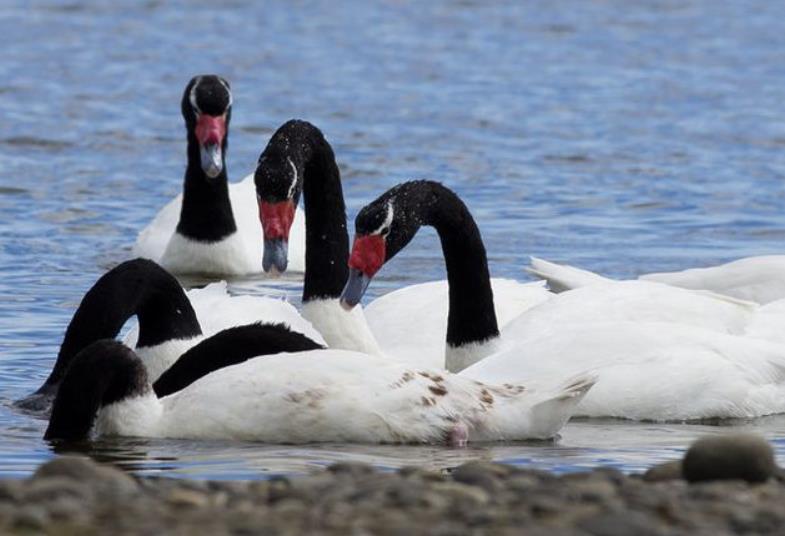black-necked swan
IUCN
LCBasic Information
Scientific classification
- name:black-necked swan
- Scientific Name:Cygnus melanocoryphus
- Outline:Waterfowl
- Family:Anseriformes Anatidae
Vital signs
- length:90-130cm
- Weight:3.5-4.4kg
- lifetime:25-35 years
Feature
One of the most emotionally devoted animals
Distribution and Habitat
The black-necked swan is a type of swan native to South America. It breeds in Paraguay, Uruguay, Chile, Argentina, Tierra del Fuego and the Falkland Islands in South America. It migrates north in winter to Paraguay and southern Brazil near the Tropic of Capricorn. area. Black-necked swans like to live in freshwater or brackish swamps, lakes and lagoons where aquatic plants such as cattails, banana grass, rushes, reeds and duckweed exist. In the dry season, they spread to inland grasslands, estuaries and beaches. They live in other places and sometimes even inhabit coastal areas where a large amount of seaweed grows, feeding on various algae growing on rocks.
Appearance
The plumage colors of the male and female black-necked swans are very similar, but the female is smaller than the male. With a body length of 90-130 cm and a weight of 3.5-4.4 kg, it is the smallest swan in the world. The body feathers of the black-necked swan are the same as the whooper swan, which is also snow-white, but its head and neck are black, making it look different and unique. On its forehead, there is also a large bright red fleshy crown called a wart, which is very bright and developed. Its cheeks are red, its beak is blue-gray, its beak is off-white, and its tarsus and webs are pink.
Details
The black-necked swan is a swan with a black neck and white body. It mainly feeds on various aquatic plants, seaweeds, algae and a small amount of aquatic insects, fish eggs and crustaceans. In some places, it mainly feeds on a certain kind of aquatic plants.
Black-necked swans mainly live in the water. When swimming, their necks are bent and their heads are lowered, with an extremely elegant posture. When flying, the neck is straight forward, the legs are stretched back, and the wings are flapped slowly and powerfully. When foraging, they mostly choose open shallow water areas and constantly poke their heads and necks into the water to feed on the abundant food on the upper surface of the water, but they rarely stand upside down in the water to feed. Black-necked swans are less courageous and highly vigilant. When frightened, they scream and flap their wings and fly away from the water. But usually, its cry is very weak, sounding like a wheezing sound, and it doesn't carry very far.
Black-necked swans like to live in clusters, and sometimes mix with migratory birds such as flat-billed geese, but the number of clusters is usually not large. In the blue sky, they sometimes stretch their wings and soar and hover, sometimes like flying arrows from a string, swooping down to the water's surface, extremely light. When floating quietly on the lake, it looks like a fairy, leisurely and contented, with various postures, poetic and picturesque, which makes people dizzy and excited. During the non-breeding season and dry season, thousands of black-necked swans can often be seen living together in clusters, often fighting with each other. When there is drought or the water level is too high, they often spread and migrate over a certain distance.

Black-necked swans start breeding in July every year, but if the food is very abundant, they may also start breeding from March to April. Under artificial breeding conditions, individuals at the age of 2 can be paired for breeding, but under natural conditions it will be later. The courtship ceremony of black-necked swans is more intense than that of other swans. They usually chase their opponents by lowering their heads and stretching their necks. After the male and female birds pair up, they live together, always inseparable for foraging, activities, etc., and then find a secluded place to build a nest together. Nesting begins as early as July, and the southern populations do not start nesting until September. The nest is usually built on reeds or on small islands, and the nest materials are mainly made of grass, branches, etc.
Each clutch lays 4-8 eggs, which are cream-colored and weigh an average of about 220 grams. The female bird is responsible for incubating the eggs alone, while the male bird is on guard near the nest. When the female bird leaves the nest to look for food, she will temporarily incubate the eggs. The incubation period is approximately 34-39 days. Black-necked swans occasionally nest in groups, but due to the lack of sufficient food and nesting sites, fierce fighting will occur, resulting in a very low average number of eggs in the clutch and a reduction in reproductive success rate. The hatched chicks are precocious and are raised by the male and female birds together. Since the adult bird moves in the water almost all day long, the chicks lie on the adult bird's back and follow the adult bird's movements. The chicks grow more slowly than other swans. Because the calories contained in food are very low, more nestlings and young birds die from malnutrition, such as bone deformation, and many individuals have parasites such as nematodes and flukes in their stomachs. The feathers of young birds are brownish-gray when they grow up, and change to the color of adult birds one year later, but they are still relatively small and have no crest on their foreheads.








